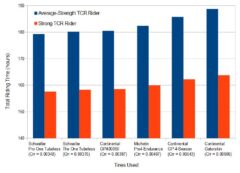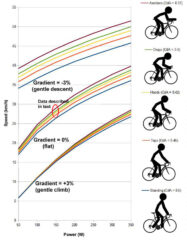Rolling resistance is the energy lost by the tires deforming as the wheels turn. Despite rolling resistance only accounting for about 10% of the total resistance experienced by a typical ultra-distance cyclist over an entire race, different tire choices can make a significant impact on average cycling speed.

Page Contents:
Method
The tire rolling resistance values shown on BicycleRollingResistance.com were used because that website contains the most up-to-date and complete list of tires (for further discussion about rolling resistance, see the Blather ’bout Bikes blog and the Silca blog). See the General Method page for more information and the Types of Resistance page for estimates of what proportion of a cyclist’s total resistance is caused by the tires.
Results
Degrees of Puncture Resistance
The Continental Grand Prix 4000S II (Amazon) is a very popular tire with ultracyclists because it not only has quite low rolling resistance, but also has reasonable puncture protection and decent longevity. This is therefore the tire that is used in the standard simulations that are reported throughout this section of the website.
Because punctures cost self-supported cyclists time, some ultracyclists choose a more robust tire like the Continental Grand Prix 4-Season (Amazon). Extra puncture protection requires more material in the tire tread, which causes more rolling resistance, but how much does this affect the expected riding speed? Unfortunately, this tire has 40% higher rolling resistance than the GP 4000S II, which causes the average speed to drop by 0.6 km/h, and so increases the total cycling time predicted for the 2016 Transcontinental Race (TCR) by over 5 hours, making the predicted finish time almost half a day later.
Some ultracyclists’ fear of punctures is even greater and so they choose the even more robust Continental Gatorskin (Amazon), which has one of the highest rolling resistance values of any road tire. Using that would cause the average speed to be reduced by a further 0.3 km/h compared to someone with the GP 4-Season tires, or a further 3 hours of riding time.

Inner Tubes
Supple, latex inner tubes cause less rolling resistance than butyl inner tubes, yielding an improvement of about 0.2 km/h or up to 2 hours less riding time on the complete 2016 TCR route. The disadvantages of latex inner tubes are that they lose air quickly (they need pumping up every day), they are delicate and easily damaged during installation, and they are not as easy to repair. I therefore don’t recommend using them for self-supported cycling.
Butyl inner tubes are available in standard and lightweight versions. The lightweight versions have significantly less rolling resistance (a difference of about 0.1 km/h) and are more compact and so spares are easier to store, but the thinner walls are more susceptible to pinch flats, which Continental acknowledges on their website: “lightweight tubes have a lower thickness and so it is imperative that inflation pressures are maintained to prevent the risk of pinch flats”. I’ve found that the rate of punctures from things piercing the tire (glass, metal, etc.) is the same with standard and lightweight inner tubes because anything that makes it through the tire will go through any inner tube, but I did experience more pinch flats than normal when using lightweight tubes even when using appropriate tire pressures, so I have mostly stopped using them.
Tubeless Tires
The Schwalbe Pro One Tubeless tire (Amazon) is the most popular tubeless road tire and has a rolling resistance that is even lower than the Continental GP 4000S II. Using the Pro One Tubeless would save almost 1 hour of total cycling time compared to the GP 4000S II and possibly more if some punctures are avoided due to having a tubeless system. See the Discussion section below for the advantages and disadvantages of tubeless tires.
Tubular Tires
Tubular tires are not a good idea for a self-supported race due to the difficulties of carrying spares, changing tires, and repairing punctures. Although 20 years ago, good tubular tires had lower rolling resistance than the best clincher tires, this is no longer true. In fact, some modern clincher tires have lower rolling resistance than the best tubular tires, which is why Tony Martin chose to use clincher tires to win the 2016 World Championship Time Trial.
Tire Width & Pressure
How tire pressure affects rolling resistance on real roads is difficult to establish. Most laboratory-based tests of rolling resistance find lower resistance at higher pressures, but this doesn’t always transfer to riding on actual roads. The results presented here assume that the tires are kept at 100 psi (6.9 bars). In general, rolling resistance with a road tire (23 to 28mm wide) is at a minimum somewhere in the range of 80 to 120 psi (about 6 to 8 bars) on most roads, with most tires, for people of most weights, but it’s very hard to say what is the ideal pressure.
Although it’s difficult to say what the ideal pressure is, it’s certain that using about 60 psi (4.1 bars) or less in road tires instead of around 100 psi (6.9 bars) causes additional rolling resistance, with the increase being about 20% to 40%. The average speed would be predicted to be reduced by about 0.5 km/h due to having under-inflated tires, or 4 hours more of total cycling time. If riding under-inflated tires also leads to extra punctures due to pinch flats then even more time may be lost.
Wider tires (i.e., 25 or 28 mm) are sometimes found to have lower rolling resistance than narrower tires (23 mm), but not always. The tests are all done with a standard air pressure in all tires, but most people use wider tires so that they can gain comfort by using a lower air pressure. At those lower pressures, the rolling resistance is higher on smooth roads (due to the tire deforming more). Therefore, in real-world usage, wider tires probably don’t have lower rolling resistance than narrower tires, but they do give more comfort, which is important.
Wider tires are far more suitable when riding on dirt roads and cobbles due to extra comfort and puncture protection. However, such surfaces are unlikely to make up a large enough proportion of the route to base tire decisions purely on that section, and so a compromise must be reached to get the optimal choice across the entire route.
The rolling resistance of all tires is increased when the air temperature drops. This effect is covered on the Environmental Factors page.
Discussion
Which tires are used is probably the decision that affects finishing times more than any other piece of equipment, and is the most often overlooked. Although there are many options other than the Continental and Schwalbe tires discussed above, I wouldn’t consider using any tire for which I cannot find an independently-measured value of rolling resistance and which I didn’t have extensive personal experience with so that I know it has a decent level of puncture resistance and longevity. Good sources for independently-measured rolling resistance values are: BicycleRollingResistance.com, the spreadsheet linked to in the top-right of Tom Anhalt’s page, a VeloNews article, a Tour article, and a BikeRadar article.
The 5 hour difference in cycling time (10 hours elapsed time) between the Continental GP 4000S II tires and the 4-Season model is impressive. It is the same difference that is predicted for a total Weight Increase of more than 7 kg! For this tire choice to be justified, the cyclist would have to predict that they’ll spend about 20 minutes per day fixing punctures if using the GP4000S II tires and that the 4-Season model would prevent all punctures, but neither of these things are very likely. The Gatorskin tires provide even more protection but are slower still, so could only be justified by someone who has no confidence in their ability to fix punctures by themselves, which probably means that they are not suited to doing bikepacking races.
Why is it so much easier to make a large difference in the predicted speed by changing tires than it is when reducing the total weight? The answer is that significant absolute changes in weight (e.g., 5 kg) are not so large when the total system weight is included (5 kg out of 85 kg = 6%), and it only makes a difference when climbing significant gradients, so the predicted overall change in speed is quite small. In contrast, some tires can have a rolling resistance that is 40% less than other models and rolling resistance is always taking away energy across the entire route, which makes the predicted change in speed relatively larger.
Instead of using a more robust tire to guard against punctures, using tubeless tires could be an option because there are some fast-rolling tubeless tires (e.g., Schwalbe’s Pro One). With liquid sealant added inside the tire, small punctures are sometimes re-sealed without the rider even needing to stop, and pinch flats are almost impossible because there is no tube to pinch. Larger cuts can still cause a puncture that may be repairable by inserting a ‘plug’ into the tire (Amazon) or by using a standard inner tube.
There are some drawbacks to tubeless road tires: They can only be used on rims that are labeled as being compatible, special rim tape and valves are needed (which each occasionally cause leaks that are difficult to diagnose), the tires can be a little problematic to inflate and seal initially, and they can be more difficult to unmount from and remount to the rim if an inner tube does need to be inserted (which can be a particular problem if your hands are not working properly during an ultra-distance race due to ulnar palsy). Finally, tubeless tires are certainly not immune to failures, as I’ve discovered in multiple ways while using them in two editions of the TCR, which is why I’ve now stopped using them on my own bikes. Other people have had far more success than me with tubeless tires. Although the sealant is supposed to plug small holes, I’ve often found that it fails to hold permanently at road tire pressures (above 70 psi / 5 bars) and other people have reported the same.
Because riding on under-inflated tires loses a reasonable amount of energy and speed, carrying a pump with an integrated pressure gauge and that it is easy to use to get the tires up to sufficient pressure is worthwhile. I recommend the Topeak Road Morph G (Amazon). The tires should be pumped every few days to maintain protection against pinch flats and to optimize rolling resistance.
Although wider tires may not yield lower rolling resistance, they certainly do give more comfort if a lower air pressure is used (their comfort benefits are discussed on the Saddle Comfort: Saddle, Shorts & Tires page). However, a wider front tire won’t be as aerodynamic as a narrower tire – ideally the front tire should be narrower than the rim, see the Air Resistance of the Bike page.
Last significant page update: November, 2016
This page is in the What Determines Cycling Speed? section. The next page in this section is:

